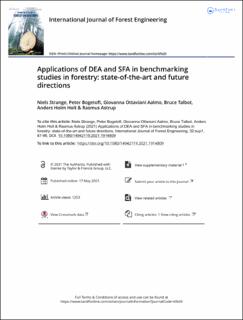| dc.contributor.author | Strange, Niels | |
| dc.contributor.author | Bogetoft, Peter | |
| dc.contributor.author | Ottaviani Aalmo, Giovanna | |
| dc.contributor.author | Talbot, Bruce | |
| dc.contributor.author | Holt, Anders Holm | |
| dc.contributor.author | Astrup, Rasmus Andreas | |
| dc.date.accessioned | 2022-03-02T14:12:31Z | |
| dc.date.available | 2022-03-02T14:12:31Z | |
| dc.date.created | 2022-02-10T21:41:35Z | |
| dc.date.issued | 2021-05-17 | |
| dc.identifier.citation | International Journal of Forest Engineering. 2021, 32 87-96. | en_US |
| dc.identifier.issn | 1494-2119 | |
| dc.identifier.uri | https://hdl.handle.net/11250/2982582 | |
| dc.description.abstract | The forestry sector is constantly looking for ways for making data-driven decisions and improving efficiency. The application of Data Envelopment Analysis (DEA) and Stochastic Frontier Analysis (SFA) allow the users to go beyond looking at simple key performance indicators. Benchmarking is one of the most common tools in business for improving efficiency and competitiveness. This study searched for benchmarking studies in Web of Science until December 2020. It reviewed 56 benchmarking studies in forestry and discusses the potential advantages of using benchmarking in forestry. More than 80% of the studies apply DEA. This review found that almost half of the benchmarking studies in forestry have attempted to estimate the efficiency of forest management organizations at regional scale, mostly being public or state-owned forest districts. A bit more than one-third of the studies have focused on benchmarking forest industries and one-fifth, benchmarking of forest operations. Forest management organizations mainly applied benchmarking for internal comparison and forest industries entirely focused on competitive benchmarking. Surprisingly, in most cases the studies do not necessarily overlap geographically with forest rich countries (e.g., Russian Federation or Brazil). A number of studies address multiple criteria. The future potential for applying automatic data transfer from harvest machines to interactive benchmarking systems are discussed. Finally, the paper discusses the advantages and weaknesses of benchmarking and future research on improving usefulness and usability of benchmarking in forest businesses. | en_US |
| dc.language.iso | eng | en_US |
| dc.publisher | Taylor & Francis Group LLC | en_US |
| dc.rights | Attribution-NonCommercial-NoDerivatives 4.0 Internasjonal | * |
| dc.rights.uri | http://creativecommons.org/licenses/by-nc-nd/4.0/deed.no | * |
| dc.title | Applications of DEA and SFA in benchmarking studies in forestry: state-of-the-art and future directions | en_US |
| dc.type | Peer reviewed | en_US |
| dc.type | Journal article | en_US |
| dc.description.version | publishedVersion | en_US |
| dc.rights.holder | © 2021 The Author(s) | en_US |
| dc.source.pagenumber | 87-96 | en_US |
| dc.source.volume | 32 | en_US |
| dc.source.journal | International Journal of Forest Engineering | en_US |
| dc.source.issue | Sup1 | en_US |
| dc.identifier.doi | 10.1080/14942119.2021.1914809 | |
| dc.identifier.cristin | 2000250 | |
| dc.relation.project | EC/H2020/720757 | en_US |
| cristin.ispublished | true | |
| cristin.fulltext | original | |
| cristin.qualitycode | 1 | |

